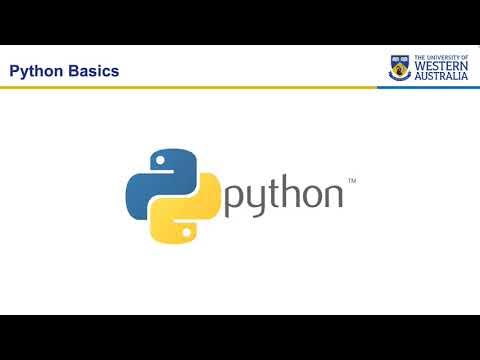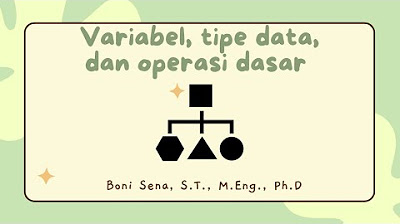Belajar Python [Dasar] - 05 - Tipe Data
Summary
TLDRThis Python tutorial introduces the basics of data types, covering integers, floats, strings, booleans, and complex numbers, while explaining their usage in Python. The instructor also demonstrates the concept of importing C language data types like doubles for more advanced operations. The video emphasizes how Python handles data types automatically, such as treating 10 as an integer and 1.5 as a float. The lesson also touches on converting between different data types. Ideal for beginners, this tutorial helps viewers understand and work with Python's essential data types to get started with programming.
Takeaways
- 😀 Python supports various data types that can be assigned to variables, such as integers, floats, strings, and booleans.
- 😀 Integer data types represent whole numbers, both positive and negative, without any decimal points (e.g., a = 10).
- 😀 Float data types are numbers with decimal points (e.g., 1.5), used when more precision is needed in calculations.
- 😀 String data types represent sequences of characters, enclosed in quotes (e.g., 'Ucup').
- 😀 Boolean data types can only have two values: True or False, used for binary or logical operations.
- 😀 Python automatically recognizes data types, so there's no need to explicitly declare them like in other languages.
- 😀 Complex numbers in Python are represented by real and imaginary parts (e.g., 5 + 6j).
- 😀 Python allows using C libraries to expand the available data types, such as the `double` type for larger floating-point numbers.
- 😀 Conversion between data types is possible in Python, allowing flexibility in handling different kinds of data.
- 😀 Indentation in Python is important for organizing code and ensuring it runs correctly, especially when handling multiple data operations.
- 😀 The script provides a fun and engaging way to learn about Python’s data types, with informal and light-hearted explanations.
Q & A
What is the main topic of this tutorial?
-The main topic of this tutorial is an introduction to Python's basic data types, explaining their usage and how they work in Python.
What is the first data type discussed in the script?
-The first data type discussed is 'integer,' which represents whole numbers, such as 1, 145, or any other number without a decimal point.
How does Python handle integers?
-In Python, integers are automatically recognized by the system. When a value is entered as a whole number, Python identifies it as an integer, without needing any special designation.
What is the difference between integers and floats in Python?
-Integers represent whole numbers without decimals, while floats represent numbers with decimal points. For example, '1' is an integer, and '1.5' is a float.
Can you explain the use of the 'str' data type?
-The 'str' data type represents strings, which are sequences of characters enclosed in either single or double quotes. It can be used for text-based data, like names or any other collection of characters.
What is a boolean data type in Python?
-A boolean data type in Python can only hold one of two values: True or False. It is used to represent binary conditions, such as logical operations or comparisons.
What is a complex data type and when would you use it?
-A complex data type in Python represents numbers with a real and an imaginary part, for example, '5 + 6j'. It is typically used in mathematical computations involving complex numbers.
Does Python have a 'double' data type?
-No, Python does not have a specific 'double' data type. However, Python uses 'float' to represent floating-point numbers, and if higher precision is needed, external libraries like C can be used to import a 'double' type.
How does Python handle data conversion?
-Python allows for data type conversion, such as converting between integers, floats, and strings, using built-in functions like int(), float(), and str(). This process is known as typecasting.
What is the role of libraries or external packages in Python data types?
-Libraries or external packages in Python, like those from the C programming language, allow for the use of additional or more specialized data types, such as 'double', that are not natively available in Python.
Outlines

This section is available to paid users only. Please upgrade to access this part.
Upgrade NowMindmap

This section is available to paid users only. Please upgrade to access this part.
Upgrade NowKeywords

This section is available to paid users only. Please upgrade to access this part.
Upgrade NowHighlights

This section is available to paid users only. Please upgrade to access this part.
Upgrade NowTranscripts

This section is available to paid users only. Please upgrade to access this part.
Upgrade NowBrowse More Related Video

Learn Python VARIABLES in 10 minutes! ❎

UWA CSSE Core Python Programming - Python Basics

Tipe Data dan Variabel - Google Colab - Belajar Python Pemula - Eps.3

Variabel, tipe data dan operasi dasar

GCSE Computer Science Python #1 - Variables, Constants and Assignments

Belajar Python [Dasar] - 18 - Format String
5.0 / 5 (0 votes)